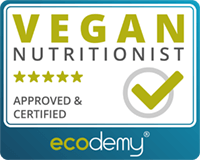Fibre In Relation To Health, Vegan Dieting & Athlete’s Digestion
With simple and practical tips on reducing the burden of dietary fibre in the digestive system

Visit activeplantbased for professional help and plant-based nutrition training.
Key points
- Eating vegan does not automatically result in a high-fibre and low-energy diet.
- A diet rich in fruits and vegetables promotes strong muscles, good digestion, better sleep and overall health.
- Especially for athletes, it boosts endurance and speeds up recovery.
- Fibre is good for your gut health, including your gut bacteria.
- It can lower cholesterol and helps your digestive system run smoothly.
- Consuming fibre on a daily basis prevents overeating and keeps you full for extended periods.
- There is a distinction between soluble and insoluble fibre.
- Some of the highest sources of soluble fibre are: legumes, whole grain products, dark green and orange vegetables etc.
- Some of the highest sources of insoluble fibre are: whole grain foods, wheat and corn bran, legumes, seeds, nuts etc.
- You can reduce the strain of fibre consumption by chewing your food more, choosing foods that are higher in energy, adding healthy fats, swapping some fruit for smoothies etc.
A week ago, I visited a hairdresser in Cyprus. We got into a conversation with the sympathetic girl who worked there, and she was curious about why I was in Cyprus (just for fun) and what my profession was.
I answered that I am a vegan nutritionist, and her first question was whether or not salad is harder to digest than meat. I formed an inner smile because that is exactly what I assumed salad and greens to be: Hard to digest + some vitamins. That is not quite the case.
Our biochemistry professor in medical school said this, and here I quote.
“Dietary fibre is useless to humans, as we cannot digest it. We eat it, and then it comes out, and that’s it.” — My biochem prof who’s wrong about dietary fibre.
Interestingly, the word dietary fibre in German means Ballaststoff, literally translated to ballast substance.
Ballast means burden, baggage, or dead freight. Regarding the actual word used in German, his statement seems justified.
“Originally, it was thought that dietary fibre was completely indigestible and did not provide energy. It is now known that some fibre can be fermented in the large intestine by gut bacteria, producing short chain fatty acids and gases.”
— British Nutrition Foundation (2018)
And even dead freight has its use cases. Huge ships have tanks for ballast, so the ship’s stability improves. So what does dietary fibre help if you cannot digest most of it?
Fibre Talk
Should I consume fibre?
Absolutely. First, let’s discuss health and eating a plant-based diet as it is perceived as a high-fibre and low-energy diet. When people think about veganism, they think about carrots and lettuce.
Although there is nothing inherently wrong with crunchy orange and green vegetables, it’s far from the truth that eating vegan automatically results in high-fibre and low-energy foods.
Health and veganism
Regarding vegan nutrition in terms of health, there is zero doubt that plants are the way to go.
Generally speaking, a diet rich in fruits and vegetables promotes strong muscles, good digestion, better sleep and overall health.
For our athletes, it also boosts your endurance and speeds up recovery after training, making you less likely to get injured or ill.
Health benefits of fibre
Loads of fibre might strain your body, but that does not mean that dietary fibre should be avoided or kept low. Quite the opposite! A diet high in fibre is associated with good health and a lower risk for various diseases.
About 68% of men and 75% of women consume less fibre than the German Nutrition Association (DGE) recommends. Your daily value of fibre should be at least 30g. Thankfully, with plant-based dieting, you will reach that threshold quickly.
Fibre is good for your gut health, including your gut bacteria
Dietary fibre serves your gut health and is linked to several other health benefits. It is also known that the health of your gut bacteria influences your overall health, including your mental health.
Besides fibre, fruits and vegetables contain lots of vitamins, minerals, antioxidants and other compounds essential to good health.
By eating right, eating enough calories and protein to fuel your brain and body, you can optimise your athletic performance and boost your health simultaneously.
Fibre can lower cholesterol
Vegetables, in particular, are high in fibre. It is a nutrient that helps lower cholesterol and helps keep your digestive system running smoothly. It can also help prevent or improve constipation, depending on the fibre, while maintaining blood sugar levels.
Healthy blood sugar levels prevent hunger cravings which can prevent overeating and help keep you feeling full for extended periods.
Fibre can boost energy levels and reduce tiredness and fatigue. This means that by eating more foods rich in fibre, you are helping to improve your well-being and your athletic performance.
Types of dietary fibre
Before we get to our dietary fibre sources, we need to understand that there is a distinction between soluble and insoluble fibre.
It’s best if you think of the soluble fibre being used and fermented by the friendly bacteria in the gut, whereas the same bacteria cannot use insoluble fibre.
When bacteria ferment the fibres, it also produces gases. This is the reason why you might feel discomfort or flatulence.
Note. There is an overlap between soluble and insoluble fibre within one plant. That means that most foods contain both soluble and insoluble fibres.
For instance, a plum’s outer skin contains insoluble fibres that cannot be used for fermentation by your friendly gut bacteria. The inner fleshy and juicy part contains soluble fibres that are useful for your microbiota.
That doesn’t mean that you shouldn’t eat the skin of your fruits, as they contain the most vitamins. Whenever you can, and it is safe to do so, eat the skin of your fruits and veggies or use them otherwise to reduce waste.

Sources of dietary fibre
You can find fibre in all plant foods. The amount varies from food to food.
List from highest to lowest source of soluble fibre:
- legumes, such as peas, soybeans, lupins, and other beans
- whole grain foods, including oats, rye, chia and barley
- dark green vegetables, like broccoli,
- orange vegetables, like carrots and sweet potatoes
- starchy veggies and root vegetables, including onions, potatoes, topinambur
- some fruits, like figs, avocados, plums, prunes, berries, pineapple, apples, pears
- nuts, with almonds being the highest in dietary fibre in the nut realm
Sources of insoluble fibre:
- whole grain foods
- wheat and corn bran (the outer shell of wheat or corn)
- legumes, such as beans and peas (also a source of soluble fibre)
- nuts
- seeds
- cauliflower, zucchini, celery, nopal
- some fruits, including avocado and unripe bananas
- fruit skin of kiwi, grapes, tomatoes, plums…
Percentage of fibre in plant sources
- > 10%
rye, rye crispbread, wholemeal rye flour, rye shred, wheat bran - 5%-10%
dates, spelt, peanuts, figs, barley, pearl barley, hulled oats, oat flakes, hazelnuts, elderberries, corn, almonds, nuts, pumpernickel, quinces, rye flour and all types of flour, mixed rye bread, blackcurrants, sultanas, wholemeal bread, wholemeal pasta, walnuts, wheat, wheat semolina, wheat flour - 2 %-4.9 %
apples, apricots, artichokes, avocados, bananas, pears, cauliflower, beans, peas, fennel, kale, blueberries, raspberries, pumpkin, lentils, carrots, brussels sprouts, sauerkraut, toast, wheat rolls, mixed wheat bread, wheat flour, onions - <2 %
pineapples, aubergines, strawberries, cucumbers, potatoes, cherries, lettuce, tangerines, melons, peaches, plums, asparagus, spinach, tomatoes, grapes, courgettes/zucchinis
Digestion
Now that we know the effects on our body and sources of dietary fibre, we need to talk about digestion and how we might reduce the strain of a high fibre intake in our diet.
Athletes and veganism
As an athlete, I might find it somewhat challenging to cover (let’s assume) 3500 kcals and my protein intake while following a vegan diet, especially when I’m new to plant-based dieting.
Maintaining a steep amount of calories with vegetables, rice and lentils sound straining for the gastrointestinal tract.
For more information about vegan protein intake please read “Achieving Your Protein Goals As A Vegan. Part I & Part II”
Balance and learn what feels right for you
Learning how to adapt and accommodate your needs, whatever those might be, will be essential. Balance and planning is the answer.
Given that you follow a balanced diet along with some valuable tips and tricks, a plant-based vegan diet can positively affect your performance!
Practical tips on how to reduce the strain of high-fibre consumption
- Chew: Every second, someone is wolfing his food. Be present, eat mindfully and chew loads and loads. Chewing activates your jaw muscles, prepares your belly for food, prevents bloating, and breaks down parts of your food mechanically and enzymatically, reducing the work that your stomach and bowels need to do otherwise
- Opt for foods high in energy: Choose foods like avocados, coconut milk, nuts, seeds, vegetable oils and vegetable fats
- Purée your food: Make shakes, soups and purées as they help with the feeling of hunger. The process of puréeing breaks down your veggies and fruits into smaller parts even before they enter your system
- Add sauces and oils high in calories to meet your daily needs without overeating
- Add more (healthy) fats to your diet.
- Swap some fruits with dried ones or turn them into smoothies or juices. Frozen fruit with a small amount of liquid turns into a sorbet-like consistency that you can use as an excellent dessert
- Protein powder is a good option for increasing your protein intake
- Cover your carbohydrate needs, especially before intensive training, using isolated sources of carbs
- Cheese and meat substitutes, as well as salty snacks, prepackaged juices and sweets consumed in moderation, will also help with your energy levels in case you cannot meet them yet
Overall, it is best to opt for energy-dense plant-based foods, whose fibre content is low, relatively speaking. Purée your meals and add fats and isolated carbohydrates to them. That will not impair your digestive system and will help minimise the feeling of hunger.
It is safe to say that a vegan diet is suitable for all needs, whether you want to increase, decrease or maintain your weight and calorie intake. It’s all a matter of knowing how to assist your body.

